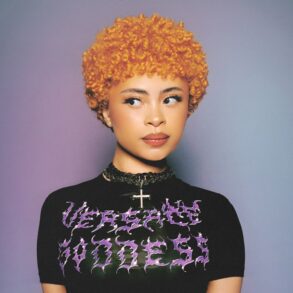The year 1998 was part was part of the “Shiny Suit Era” of hip-hop, when the music promoted the wealth, consumption, and success of its artists while also serving as therapy, a celebration of life in the aftermath of the killings of Tupac Shakur and The Notorious B.I.G. That year also marked the launch of Howard University’s Verbal Armageddon, which quickly became the largest college hip-hop tournament in the country.
A particularly memorable battle that first year involved two campus favorites and classmates: Perfecto vs. StarOrion.
Perfecto (Jeffrey Walsh), from Inglewood, California, was Howard rap-famous for a complex, multisyllable style (“compounds,” he called them). He sounded two parts Kurupt (from Tha Dogg Pound), one part Freestyle Fellowship, and all parts original. StarOrion (Charles Coleman) was a pre-law student who rhymed with the characteristic moxie of artists from his native Queens, New York. He sported a mature rapper persona, with a polished stage presence.
While they only traded light barbs, as they were friends who respected one another, their battle gave a taste of the talent and success that Verbal Armageddon would attain in the next few years. That day, StarOrion triumphed by a nose, his command over the crowd proving to be the difference.
Verbal Armageddon was like many endeavors authored by college students: bold, inventive, and unquestionably a product of the zeitgeist. As important as the Shiny Suit Era was, it also left a void: Hip-hop was not a monolith, and a large fraction of its fan base — even those who embraced the gloss of a music video directed by Hype Williams — yearned for the raw energy of basements and street corners. Hip-hop was entering its second generation, in which the regional signatures had fully emerged. Walking through a Howard dormitory, one could hear Master P, Ma$e, Shakur, and the Wu-Tang Clan thumping from different speakers down a single hallway. All these forces collided on college campuses, especially at events like Verbal Armageddon.
The original concept came from Iman Kennerly, who entered Howard in 1997 eager to learn everything he could about the local hip-hop scene like he had in his native Newark, New Jersey. Kennerly was known for his love of The Roots and freestyle rhymes full of 10-cent words. (“Chillin’ in front of Blackburn [student center]/ lyrics is taciturn.”) As a freshman, he hosted a program on the student radio station and was part of a team that organized a campus talent show featuring a rap battle. Through it all, he thought there was more work to be done.
“I knew a lot of the people who rhymed from various cyphers on campus. But I noticed that when they performed on stage, none of their greatness manifested,” Kennerly said. “They were raw, and needed an opportunity to refine their skills. I thought we needed a forum.”
In the fall semester of his sophomore year, Kennerly asked the Undergraduate Student Assembly to sponsor a competition titled “Verbal Armageddon.” It was designed to address the sorts of debates between college kids that lasted into the morning hours: Who was the best rapper?
To Kennerly, the debates were fun, but too informal. The way he saw it, these questions were empirical, and could be answered in the form of a “rap decathlon.” Sure, you might be able to battle, but if you couldn’t write a cohesive rhyme, then how good were you, really?
Kennerly collaborated with upperclass leaders in the campus music scene: Howard Brown, Shayla Monroe, and Amar Keiller. All mentored Kennerly, and helped to create the first iteration of the event. Keiller in particular was a veteran of the campus hip-hop scene, and helped Kennerly brainstorm and navigate the sometimes tricky path to organizing anything at Howard.
While Kennerly worked with more experienced members of Howard’s music community, it was his conversations with his classmate and best friend, Nelson Bennett, where the spirit of the event coalesced.
“We had a head of steam, but it wasn’t until the late-hour discussions with Nelson that I realized we might have something big here,” he said. “We couldn’t stop talking about it.”
If Kennerly was the strategist, then Bennett was the dreamer. He had participated in the music scene in Detroit as a street teamer, and had front row seats to all of the underground talent in that era. (He told a dinner table full of skeptical Howard students in 1997: “You gotta hear this white kid named Eminem. He is nice.“) He had ambitions for a life in the industry, but feelings of isolation led him to contemplate leaving school one month in.
“I was a loner for a long, long time. I didn’t really connect with very many people,” Bennett recalled. “It was through hip-hop that I made my very first connections.”
At first glance, they were an odd couple: Kennerly, the academic golden child, and Bennett, the kid trying to find his way. But they were both superfans of the art, raised during hip-hop’s golden years between 1988 and 1995. And they saw eye-to-eye with respect to what the campus needed.
The event would combine several elements for a competition in three rounds. Round 1 would contain the “self-definition written” rhyme. “Self-definition” embodied what is arguably hip-hop’s fundamental rhyming topic (if there is one): who you are, why you are great, and what do you care about. Topics might include some permutation of where they were from, how much money they made, how intelligent they were. (Relevant reference points included “I Got it Made,” Special Ed (1989), “Who Am I (What’s My Name)?,” Snoop Doggy Dogg (1993), and “Player’s Ball,” Outkast (1994).)
A panel of judges conducted tryouts to select for the first round, in which 24 rappers would be paired and perform, with the 12 winners (as determined by judges) advancing to the second round. The 12 members of the “losers bracket” would have to complete an “object freestyle,” in which they were given a random object that they had to rhyme about for several minutes. Four contestants from this bracket would advance, for a total of 16 entering the second round. The judging panel included a mix of students, local artists, and Howard professors.
Round 2 was based on hip-hop’s flagship sport: battle rap. The 16 rappers would be paired based on their seeding and the eight winners would advance to the final round.
The final round highlighted Verbal Armageddon’s multipronged conception of rap excellence. The finalists would have to participate in three different tasks. First, they would perform a “conscious” written rhyme. The definition of consciousness was appropriately broad: the rhyme didn’t need to be positive, but it did need to be topical, reflective, organized, or intellectual. The round was designed to test the rapper’s ability to focus and write coherent rhymes, to take the audience on a ride through their mind. (For example: “Mind Is Playing Tricks on Me,” Geto Boys (1991); “It Was a Good Day,” Ice Cube (1992); “I Gave You Power,” Nas (1996).)
Next, the artists would perform a topical freestyle. They’d pick an object from a box (examples included a pack of Skittles, a do-rag, and a Koran), and improvise-rhyme, on the spot, for several minutes.
Finally, Kennerly & Co. knew their history, and understood that the champion could only be crowned through a battle. The competition climaxed with a “final four,” determined by their scores in the conscious written and object freestyle categories, who would compete in two single-elimination rounds, after which a champion would be crowned.
Getting through the Verbal Armageddon gantlet would take a special talent. Lyrically speaking, the winner would be able to reflect, improvise, inspire, and fight.
The next challenge was recruiting talent at Howard and the surrounding area.
The team built on its social connections on campus and its members’ experience in their hometowns as promoters and street teamers. They attended events and shows in the community, and made friends with counterparts at nearby colleges. Like the sounds from the speakers in the dormitory hallways, the resulting pool of competitors put the diversity of hip-hop in perspective.
Critically, Verbal Armageddon’s inaugural champion, Fong Sai U, was not a Howard student, but an independent artist from the Washington area. This was a triumph of the efforts to make the event inclusive. It might have been held at Howard, but anyone was welcome.
“Keeping it a college thing was never on the table,” Bennett said. “That’s never how hip-hop has ever worked. It was always about being the best. We wanted to bring that to the tournament.”
However, the collection of artists was also defined by the lack of diversity in other dimensions. The event struggled to attract female participants. And like much of hip-hop’s 50-year run, too much of the energy and lyrics were populated with misogyny and the boasts of insecure young men.
“Verbal Armageddon became my central passion. It was almost like this became the reason I was in college. And so the lessons that I learned, relationships, how to manage people, and how to keep your own ego in check.”
— Nelson Bennett
Kennerly recalled that “at the start of the event in 1998, I was encouraged by the number of women who came out as spectators to the event, which definitely changed our approach to marketing from the beginning. From early, we realized that Black women were central to the success of the event.”
But, he noted, “We were not intentional enough” in recruiting female performers.
These problems aside, the event single-handedly created a campus hip-hop scene that spilled into other colleges, and the Washington area. Bennett, for instance, would coordinate battles with artists from George Mason University, American University, and others.
Verbal Armageddon was less than a nonprofit. It was a student event whose primary goal was to exist. Any proceeds went to the Undergraduate Student Assembly. But others saw the potential: sponsors on and off campus reached out. The organizers’ reputations and friendship circles grew. Attracted to the talent that Verbal Armageddon cultivated, baby music executives emerged on campus.
Verbal Armageddon’s second year felt different. Bigger. Louder. With higher expectations.
“Entering Year Two, the stakes were higher, and so if things fell through, more people would be disappointed,” Kennerly said. “There were also a lot of egos, a lot of push and pull from many different directions.”
He recalled phone conversations with Black Thought about performing at a Verbal Armageddon event. Other well-known recording artists took a break from album promotion efforts to attend. In Year Two, the battle round took place during the Howard homecoming Yardfest, before an audience in the thousands. This bolstered its claim to being the largest collegiate hip-hop tournament in the country.
The level of competition rose mightily that second year, and story arcs emerged: A rejuvenated Perfecto blitzed through the early rounds and dethroned Fong Sai U in the finals with an electric display of wordplay.
The third year was Kennerly’s last at Howard. He graduated with a degree in international business, and went to work in investment banking, before heading to the NYU Stern School of Business to complete an MBA. He recalls talking about Verbal Armageddon during his job interviews, explaining to the recruiters that hip-hop provided as good a business education as anything else.
For continuity, it helped that Bennett would remain at Howard, as a change of major added time to his college tenure. For Bennett, Kennerly’s exit was the kick in the butt that he needed in life.
“It was the first time in college that I felt like I had control over anything,” he said. “And it was more than an obligation to do right before the event. I felt like I had an obligation to hip-hop. This could be my contribution to the culture that had given me so much.”
Under his leadership, Verbal Armageddon grew over the next several years, and he became a central figure and tastemaker in the Washington hip-hop community. He eventually graduated and enlisted an entire new staff, led by Tiffany Jackson, who would replace Bennett as the coordinator in Year Six.
Jackson, now an award-winning novelist, recalled the ups and downs of the experience of taking over:
“The best part about doing Verbal Armageddon was living in the moment, on campus. I am very proud to have been a witness,” she said. “But as a woman leader of an event, I was definitely challenged in my decision-making. Of course, this is a characteristic of the industry in general. And so this set me up for knowing the types of challenges that I would face as a woman working in media.”
Eventually, between new faces on campus, and a changing hip-hop scene, the event would fade, ending its annual run after 2003. In 2007 and 2008, Bennett, who lived in the Washington area and was working in the tech industry, advised a short-lived resurrection of Verbal Armageddon.
“By 2007, the landscape of hip-hop had changed to the point where something like Verbal Armageddon didn’t really fit,” Bennett said. “For example, very few artists knew or appreciated the art of freestyle rhyming as compared to the artists a decade earlier.”
So Verbal Armageddon came and went. For all of its successes, there is no formal archive and it mainly lives on in the minds of the people who were there.
And 25 years later, we can ask broadly: What is the lasting memory or message?
For Bennett, the answer is clear: “Verbal Armageddon became my central passion. It was almost like this became the reason I was in college. And so the lessons that I learned, relationships, how to manage people, and how to keep your own ego in check.”
While several participants have gone on to have successful careers as hip-hop artists (Ardamus, iCON the Mic King, Akir, and Edan to name a few), the more intriguing story involves how the participants and student organizers went on to succeed in a wide number of crafts: law, medicine, tech, academia, education, journalism, literature, and the ministry. Ask them today about their time with Verbal Armageddon, and you get smiles, and often much more. They’ll share the bonds, the laughter, and talk about how that event gave them one of the largest stages of their young life.
In that way, the story of Verbal Armageddon isn’t so different from many of the grand lessons that we reflect on in light of hip-hop’s 50 years of existence: the hard work, creativity, and ambition of bands of young people made the culture what it is, was, and always will be.







